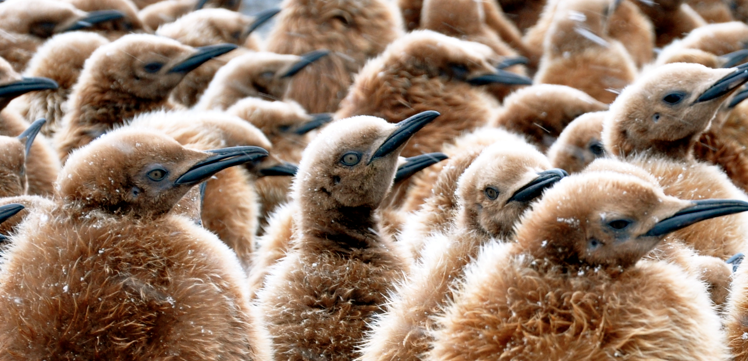Science News
Young Penguins, Far from Home
May 15, 2014
by Molly Michelson

Like many young adults, when king penguins (Aptenodytes patagonicus) reach a certain age—14–16 months in the case of the penguins—they leave their birthplace and set out into the world. But where exactly the birds go has been a mystery, and that has made this critical phase of the penguins' lives very difficult to study.
So in 2007, researchers in Antarctica fitted 18 king penguin fledglings with satellite transmitters and tracked their movements for the next 120 days. The young penguins came from two separate breeding sites—Volunteer Beach on the Falkland Islands and St. Andrews Bay on South Georgia—and foraged around the Antarctic Polar Front, or the Antarctic Convergence, a place where “mixing and upwelling create a zone very high in marine productivity,” according to a study published yesterday in PLOS ONE.
The team found that young penguins undertook large-scale movements when at sea for the first time, with their travels ranging from a total distance of 600 km to 4,000 km and averaging about 45 km per day. They also moved similarly at both locations, but more detailed analyses revealed slight differences in habitat use between the two localities. For example, juveniles from the Falkland Islands spent more time in comparatively shallow waters than those from South Georgia. However, despite differences among the birds when they're young, as they mature, they all begin to rely on the same types of habitat for food, regardless of where they hatched.
The reason they travel so far? Competition with older, more experienced, penguins, is the most likely cause, according to the study. The distance the fledglings travel “limits the level of competition between younger birds and more experienced adults foraging in the vicinity of their breeding colony after the initial dispersal, thereby reducing intra-specific competition for food,” the authors write.
Eventually, the researchers saw most of the penguins—who also wore identification bands—return to their breeding grounds at five- or six-years-old, when they were ready to mate. Welcome home, young travelers.
Image: Butterfly austral/Wikipedia